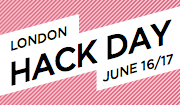RDF - What's It Good For?
One of the presentations that I missed at BarCampLondon2 (I was attending another session) was a light-hearted debate about the similarities and differences between Microformats and RDF. The main protagonists were:
- Jeremy Keith and Brian Suda in the Microformats corner
- Tom Hughes-Croucher, Tom Morris and Ian Forrester in the RDF corner.
 Thankfully, for those who didn't see the debate, Ian has uploaded a video of the session. It makes interesting viewing! And shortly afterwards, I found Ben Ward's insightful post about the whole subject too. I think Ben's second paragraph hits the nail on the head:
Thankfully, for those who didn't see the debate, Ian has uploaded a video of the session. It makes interesting viewing! And shortly afterwards, I found Ben Ward's insightful post about the whole subject too. I think Ben's second paragraph hits the nail on the head:The thing about RDF is that no-one has yet demonstrated any real-world reason to care about it. It fascinates academics who would love — just for the sake of it — to model the entire universe in triples but in the real world of web browsers the value has never really been promoted.Spot on.
The Microformats advocates have been very quick to explain what they are for, what they do, and how to implement them. I use them regularly in this blog, and try to incorporate them wherever I can into new projects. It's so easy to build them in from scratch when marking up events (hCalendar), people (XFN) or contact details (hCard).
But as yet, I'm really stumped as to what RDF - or more importantly, eRDF can do for me. Tom Morris has started a website called GetSemantic which hopes to chart the progress of developments about eRDF and spread the word. I'll be keeping an eye on it from time to time, to see what's cooking, but until then, I'll be sticking to my diet of Microformats.







2 comments:
Sorry, Caz, it's taken me a few days to respond.
eRDF is basically a way of marking up HTML to let you model it to RDF. RDF is just a data model, just as an outline or a table is a data model. It can be 'serialised' in different ways. Most of the time, people serialise it as XML, but eRDF lets you serialise it as valid XHTML.
What's useful about eRDF is that it lets you come up with some data that you want to put online and just charge in and build it. It's not an either/or with microformats. What microformats do brilliantly is let you mark up common data - like events, contacts and reviews. eRDF lets you markup things which could never become microformats. I just put up an example of how to markup a list of movies that you've watched.
One of the things that GetSemantic hopes to do is basically offer "copy-and-paste HTML" that people can use. So, it shouldn't have to matter for people what's going on - they can just look at some sample markup and use it in their own documents. And when people get to the point where the copy-and-paste samples don't suffice, the process for them to define their own extensions becomes much easier.
Tom,
Not sure your explanation has helped me much, I've still got lots to learn! But I was interested in the GetSemantic "Movies I've Watched" page, as that may well be relevent to a project in the future.
I'm just starting to get to grips with FOAF, and looking forward to the first Semantic London meetup.
Post a Comment